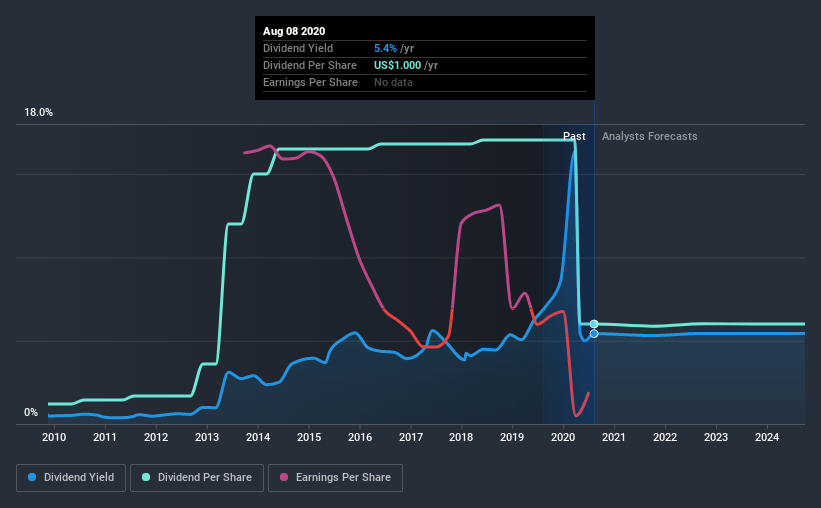Don't Buy Helmerich & Payne, Inc. (NYSE:HP) For Its Next Dividend Without Doing These Checks

It looks like Helmerich & Payne, Inc. (NYSE:HP) is about to go ex-dividend in the next 4 days. This means that investors who purchase shares on or after the 14th of August will not receive the dividend, which will be paid on the 31st of August.
Helmerich & Payne's next dividend payment will be US$0.25 per share, and in the last 12 months, the company paid a total of US$1.00 per share. Looking at the last 12 months of distributions, Helmerich & Payne has a trailing yield of approximately 5.4% on its current stock price of $18.44. We love seeing companies pay a dividend, but it's also important to be sure that laying the golden eggs isn't going to kill our golden goose! That's why we should always check whether the dividend payments appear sustainable, and if the company is growing.
View our latest analysis for Helmerich & Payne
If a company pays out more in dividends than it earned, then the dividend might become unsustainable - hardly an ideal situation. Helmerich & Payne reported a loss last year, so it's not great to see that it has continued paying a dividend. With the recent loss, it's important to check if the business generated enough cash to pay its dividend. If Helmerich & Payne didn't generate enough cash to pay the dividend, then it must have either paid from cash in the bank or by borrowing money, neither of which is sustainable in the long term. Dividends consumed 67% of the company's free cash flow last year, which is within a normal range for most dividend-paying organisations.
Click here to see the company's payout ratio, plus analyst estimates of its future dividends.
Have Earnings And Dividends Been Growing?
When earnings decline, dividend companies become much harder to analyse and own safely. Investors love dividends, so if earnings fall and the dividend is reduced, expect a stock to be sold off heavily at the same time. Helmerich & Payne was unprofitable last year and, unfortunately, the general trend suggests its earnings have been in decline over the last five years, making us wonder if the dividend is sustainable at all.
The main way most investors will assess a company's dividend prospects is by checking the historical rate of dividend growth. Helmerich & Payne has delivered an average of 17% per year annual increase in its dividend, based on the past 10 years of dividend payments.
Get our latest analysis on Helmerich & Payne's balance sheet health here.
The Bottom Line
Should investors buy Helmerich & Payne for the upcoming dividend? We're a bit uncomfortable with it paying a dividend while being loss-making. However, we note that the dividend was covered by cash flow. It's not an attractive combination from a dividend perspective, and we're inclined to pass on this one for the time being.
Although, if you're still interested in Helmerich & Payne and want to know more, you'll find it very useful to know what risks this stock faces. For instance, we've identified 2 warning signs for Helmerich & Payne (1 is potentially serious) you should be aware of.
If you're in the market for dividend stocks, we recommend checking our list of top dividend stocks with a greater than 2% yield and an upcoming dividend.
This article by Simply Wall St is general in nature. It does not constitute a recommendation to buy or sell any stock, and does not take account of your objectives, or your financial situation. We aim to bring you long-term focused analysis driven by fundamental data. Note that our analysis may not factor in the latest price-sensitive company announcements or qualitative material. Simply Wall St has no position in any stocks mentioned.
Have feedback on this article? Concerned about the content? Get in touch with us directly. Alternatively, email editorial-team@simplywallst.com.

 Yahoo Finance
Yahoo Finance 
